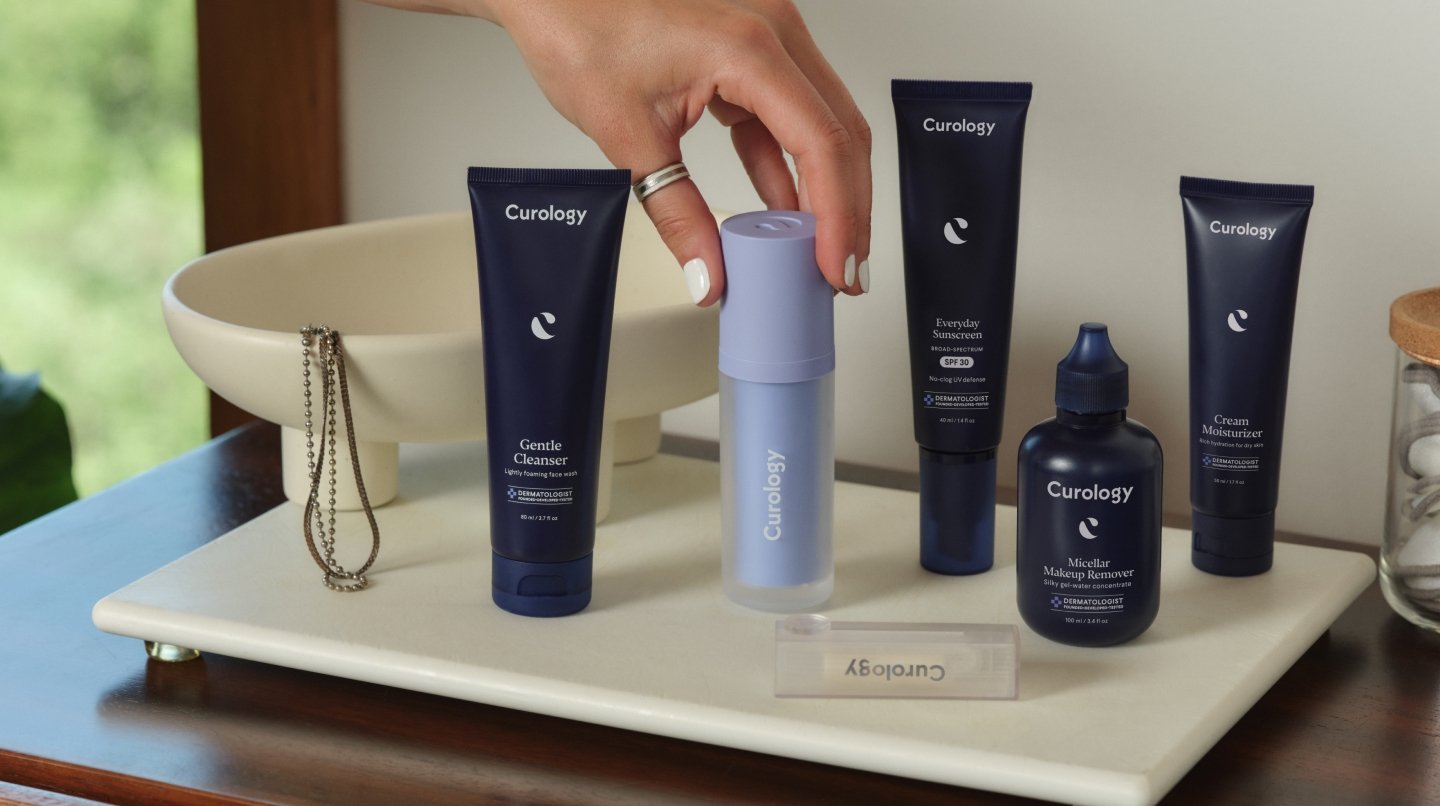How it works:
Share your skin goals and snap selfies
Your dermatology provider prescribes your formula
Apply nightly for happy, healthy skin
How it works:
How it works:
Share your skin goals and snap selfies
Your dermatology provider prescribes your formula
Apply nightly for happy, healthy skin
How it works:
How often should I change my pillowcase to help prevent acne?
When it comes to keeping your skin as blemish-free as possible, washing your sheets is important.



There’s nothing quite like slipping into a freshly made bed with crisp, clean sheets. And the benefits of clean linens extend far beyond getting a good night of rest. Your bedding can also play a role in your skin health! So if you’re wondering how often you should change your pillowcases to help prevent acne—especially if your skin is prone to breakouts—we’re here to help.
Allow us to explain why, exactly, your pillowcases might contribute to acne, and how you can maintain an optimal sleep environment that suits your skin, too.
Can pillowcases cause acne?
Technically speaking, there’s no such thing as “pillow acne.” Acne is multifactorial and is caused by excess oil (sebum) and dead skin cell buildup within the pores. This process, along with the presence of a bacteria known as C. acnes, leads to an inflammatory response resulting in acne lesions.¹
Despite all that we know about acne, there is currently no published research showing that dirty pillowcases cause acne breakouts. That said, they may still play a role in breakouts.
Especially if you sleep on your side or stomach, your face is likely to rub on your pillowcase and leave a mark (even if it’s not visible!). This could include makeup, sweat, and oils from your skin. Pillowcases could also hold droplets from your nose or mouth, as well as bacteria, fungi, and viruses.²
And if things like pore-clogging makeup ingredients are deposited on your pillow and pressed into your face, they may in theory contribute to acne breakouts. Also, if sebum (oil) is on the pillowcase, that can feed bacteria (C. acnes) that are naturally on the skin. This may trigger an inflammatory response which leads to acne formation.³
The bottom line is that regularly washing your pillowcase can be part of acne prevention because it helps keep your face clean.
How often should you wash your pillowcases?
Generally speaking, washing your pillowcases once a week is a good idea. Whether you should wash it more frequently than that depends on how dirty the pillowcase gets each night. Here are some considerations:
Do you take a shower and/or wash your face before bedtime? Or do you bring any possible buildup that is on your face to bed?
Does your skin get especially sweaty or oily?
Do you sleep with your face pressed into the pillow, or do you sleep on your back for minimal facial skin contact with the pillow?
Do you move around a lot while sleeping, potentially rubbing dirt and germs into the pillowcase?
If nothing else, you deserve the luxury of a clean pillowcase. If you can’t wash your pillowcase as frequently as you’d like, here are some other options to try:
Put a clean white T-shirt over your pillow every night.
Flip your pillowcase nightly so you don’t overuse one side more than the other.
Tips for pillowcase care
Sleeping on a clean pillowcase is important. But does the material of your pillowcase play a role in your skin health, too? Let’s dig into it.
What kind of pillowcase to buy
There is currently no research linking specific pillowcase materials to the risk of acne. So the best type of pillowcase material you buy is up to you. Cotton tends to be more breathable. However, it can absorb liquids (such as sweat and other droplets from your skin, mouth, and nose). On the other hand, silk is less likely to absorb these droplets night after night.⁴ Ultimately, the best pillowcase material is a personal preference!
Washing your pillowcase
You know, by now, that you have to clean your pillowcases—so here are some strategies to do just that.
Water temperature
To kill bacteria, you need to wash your sheets in hot water.⁵ However, you could remove oil, sweat, and makeup products at a lower temperature. Cold water is gentler on fabric, so it may be best if your pillowcase is silk or another sensitive fabric.
Laundry detergent
Some patients prefer to avoid detergents with chemicals such as sodium lauryl sulfate (SLS) or sodium laureth sulfate. While these chemicals may cause skin irritation for patients with sensitive skin, there is no research that shows avoiding them makes a difference. But if you have acne that doesn't improve after a while, an SLS-free laundry detergent may be worth considering.
Fabric softener
Fabric softeners deposit a wax-like coating on your pillowcase, and this coating could potentially get on your face and clog skin pores. That said, there is no proven connection between fabric softeners and acne.
Getting real answers about your acne breakouts
Even if you understand how to clean your pillowcases and practice good hygiene, breakouts may still happen. That’s where a proven treatment plan from Curology can help.
Get your personalized skincare routine with Curology
Get your personalized skincare routine with Curology


Board-certified dermatologist Dr. David Lortscher founded Curology in 2014 in order to provide individuals with personalized dermatology care. The sign-up process* is easy. Just complete a short quiz about your skin, upload a few selfies, and we’ll match you with a dermatology provider who is licensed to practice in your state.
Your provider will create a custom treatment plan, including a personalized formula with effective, clinically proven ingredients to help you target your biggest skin concerns. Get started now!
FAQs
There is currently no published research proving that this is the case. However, practicing general hygiene and keeping your face clean by changing your pillowcase is a good idea.
Once per week is a good rule of thumb. However, this depends on many factors, such as if you shower and wash your face before bedtime, the hair products you use, how sweaty and oily your skin is, and if you have other conditions such as dandruff or a respiratory infection.
There is currently no research about types of pillowcases that help with acne. Cotton tends to be more breathable than silk and has antibacterial properties. However, silk pillowcases repel sweat and other liquid droplets, so they’re less likely to stay on the pillow and be deposited back on your face.
P.S. We did our homework, so you don’t have to:
Zaenglein, A. L., et al. Guidelines of care for the management of acne vulgaris. Journal of the American Academy of Dermatology. (May 2016).
Han, J., and Zhang, Y. Microfiber pillow as a potential harbor and environmental medium transmitting respiratory pathogens during the COVID-19 pandemic. Ecotoxicology and Environmental Safety. (2020, December 1).
Xu, H., and Li, H. Acne, the Skin Microbiome, and Antibiotic Treatment. American Journal of Clinical Dermatology. (June 2019).
Parlin, A., et al. A laboratory-based study examining the properties of silk fabric to evaluate its potential as a protective barrier for personal protective equipment and as a functional material for face coverings during the COVID-19 pandemic. PLoS One. (2020, September 18).
Bockmühl, D., et al. Laundry and textile hygiene in healthcare and beyond. Microbial Cell. (2019, July 1).
Meredith Hartle is a board-certified Family Medicine physician at Curology. She earned her medical degree at Kirksville College of Osteopathic Medicine in Kirksville, MO.
*Cancel anytime. Subject to consultation. Results may vary.

Curology Team

Meredith Hartle, DO
Related Articles
How to use acne body wash correctly: Your straightforward guideMen skin care: top concernsFace sunscreen for sensitive skinWhat should your underarm care routine look like?SPF 15 vs. 30: What are the main differences between the two?Popular Articles
Ask Curology: Is my cold breaking me out?Slugging: The dermatologist-approved skincare hack going viral on TikTokTretinoin vs retinol: What’s the difference?How to create a self-care routine that actually sticksYour 2023 skincare horoscopeTry prescription skincare
Get routine essentials

Good skin days ahead
- Breakouts
- Redness
- Fine lines
- Dark spots
- Hair thinning